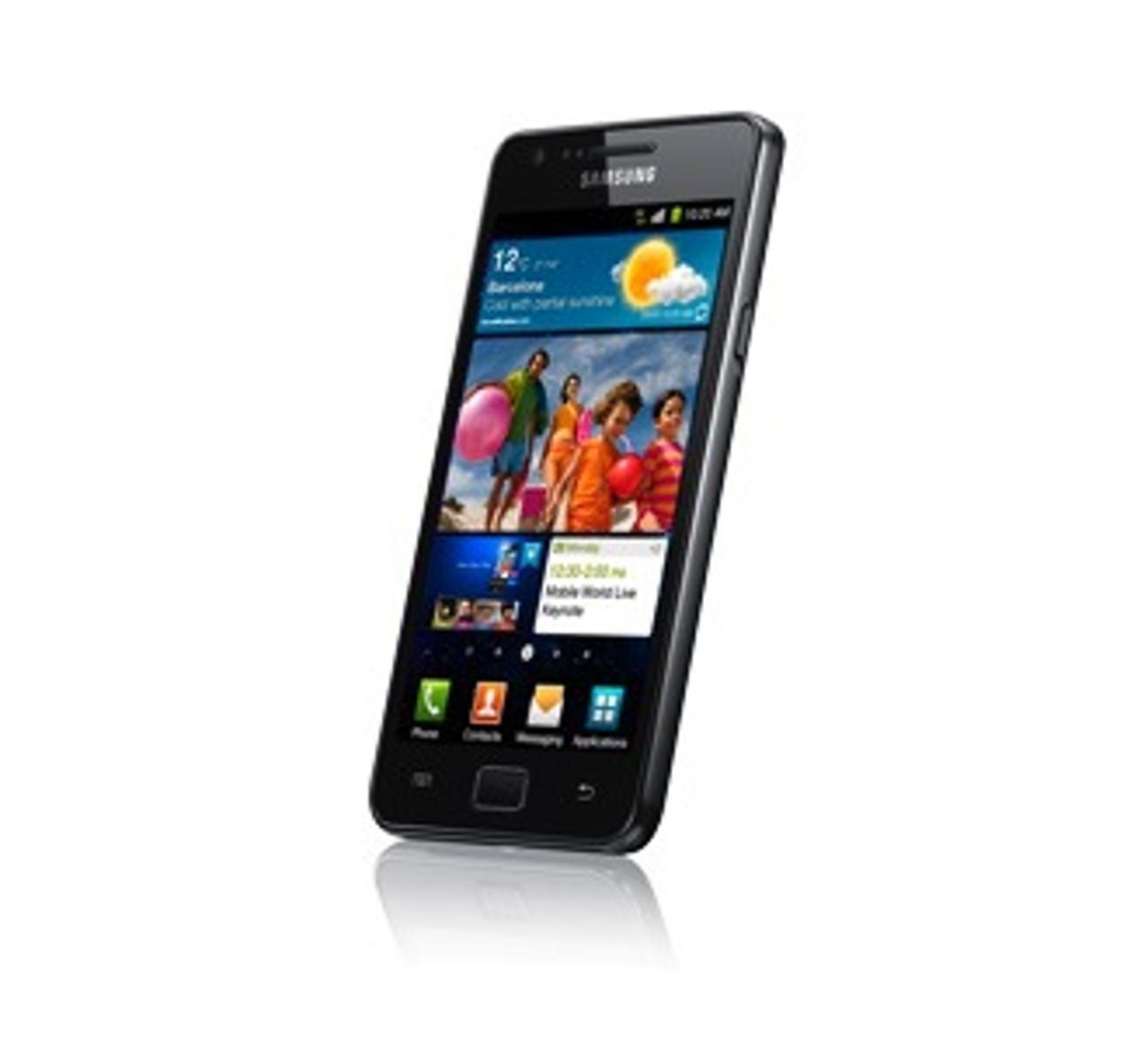Samsung Galaxy S II


Samsung Galaxy S II
Samsung is a prolific smartphone manufacturer, with three operating systems in its portfolio: its own OS, bada; Windows Phone 7, as seen in the Omnia 7; and Android, which runs on a number of handsets.
Samsung's Galaxy S scored an impressive 8 out of 10 when we reviewed it six months ago. Now the Galaxy S II sets the new benchmark for the competition to aspire to. Like LG's Optimus 2X, it features the latest must-have smartphone accoutrement — a dual-core processor. Our review sample came from Clove Technology, which sells it SIM-free for £528 (inc VAT; £440 ex. VAT). DesignThe dual-core processor may be the Galaxy S II's headline feature, but that's by no means the only noteworthy thing about it. The most visible of these is the large screen. Measuring 4.3 inches from corner to corner, this Super AMOLED Plus display is bright, sharp and extremely readable. However, the resolution of 480 by 800 pixels now seems a little low. We'd prefer a resolution to rival the iPhone 4's 640-by-960-pixel retina display (which is squeezed into a 3.5in. panel), but this isn't likely to happen until Samsung introduces its new AMOLED manufacturing process. Having said that, the Galaxy S II's screen is one of the best we've used on a smartphone: it's super-responsive to the touch, and its size means that using the on-screen keyboard for typing is comfortable in both landscape and portrait modes.
The dual-core Galaxy S II has a 4.3in. Super AMOLED Plus display, although the resolution is the same 480-by-800 pixels as its 4in. Galaxy S predecessor
We often have trouble with larger screens because we can't reach across them one-handed. The Galaxy S II has an advantage here as it's extremely thin at just 8.49mm. We still couldn't quite reach all the way across the screen, but got further than we usually do with 4-inch-plus screens.
The Galaxy S II measures 66.1mm wide by 125.3mm by tall. There's a small lip on the back of the chassis, at the bottom, which adds a couple more millimetres of thickness, while the camera surround towards the top also protrudes very slightly. Despite its large screen, the Galaxy S II weighs just 116g. Samsung has achieved this by using plastic rather than metal for the chassis. The device generally feels robust, the one exception being the extremely thin and flimsy backplate. It's quite possible that this could snap in two if removed over-vigourously. Time will tell how tough the backplate proves in everyday use. The only other design element that irks is the use of a physical Home button beneath the screen. This looks as though it should be an optical trackpad, but it isn't. The fascia shows no other buttons until the screen is on, when touch-sensitive Back and Menu buttons are backlit. A similar Home button would have been fine too. There's no Search button.Side buttons and connectors are kept to a minimum. The bottom edge has a Micro-USB connector, while the top edge has a 3.55mm headset jack. There's a thin volume rocker on the left side and a small on/off switch on the right, and that's all.
Overall, Samsung has delivered an exemplary design for a top-end large-screen smartphone.
The dual-core ARM Cortex A9 processor in the Samsung Galaxy S II runs at 1.2GHz — slightly quicker than the 1GHz dual-core chip in LG's Optimus 2X. Not surprisingly, the Galaxy S II is a responsive smartphone, with fast screen transitions and smooth-running apps. Video plays well with no pixellation, and streams quickly from online sources. The Galaxy S II runs Android 2.3 (Gingerbread), so it has full support for Flash — we were able to stream video from the BBC web site, for example, with no problems at all. Our review sample was billed as having 16GB of internal storage. In fact, there's 12GB in the handset itself, and 4GB on a microSD card. The slot is under the backplate, so you have to remove the battery to swap microSD cards. This is one of the few issues we have with the Galaxy S II. Connectivity is excellent: Wi-Fi (802.11a/b/g/n), Bluetooth (3.0) and assisted GPS. Mobile broadband (HSPA) supports a maximum upload speed of 5.76Mbps and a very impressive 21Mbps maximum download speed. You won't find that download bandwidth on offer in the UK at the moment, so there's a real element of future proofing here. The Galaxy S II's communications capabilities are bolstered by full HDMI mirroring, which means you can send anything that's visible on-screen to a suitable external device. There's no cable provided, though, and the mirroring is achieved via the Micro-USB port. Clove Technology lists the adapter, which will be available mid-June, at £24.99 (inc. VAT).
Kies Air enables easy file exchange over a Wi-Fi connection
One connectivity novelty you can use right out of the box is Kies Air. Join the Samsung Galaxy S II to your Wi-Fi network, run the app, and you get an IP address. Put this into a web browser and you can access the smartphone's memory, copying files between the main computer and handset. It's a straightforward system that others are sure to emulate.
Samsung's TouchWiz overlay for Android has been tweaked for the Samsung Galaxy S II and is now at version 4.0. It features seven home screens and puts four permanent shortcuts — to Phone, Contacts, Messaging and Applications — along the bottom of each home screen. There is a large variety of widgets available, many of which can be resized. Pulling down the notifications bar at the top of the screen gives you quick access to settings for Wi-Fi, Bluetooth, GPS, sound (which actually toggles vibrate mode) and automatic screen rotation. Samsung adds a range of apps to the standard Android bundle, and its own Samsung Apps market sits alongside the Android Market. Polaris Office lets you edit and create Word, Excel and PowerPoint documents. Mini Diary lets you make date-related notes; there are also video and photo editors, a DLNA media sharing app, and several hubs. The latter feature takes its cue from Windows Phone 7, bringing together data from disparate sources. There's a Social Hub, Music Hub, Games Hub and Readers Hub. Some of these offer the opportunity to make purchases. There's one odd feature we don't like, and that's 'tilt zoom': tap two fingers on the screen and you can tilt the Samsung Galaxy S II towards you to zoom in, away from you to zoom out. We found this unwieldy, but it's easy to ignore or even disable. Pinch-to-zoom, which is more useful, is also available. The Samsung Galaxy S II has two cameras. The main one, at the back, is an 8-megapixel unit with an LED flash. There are plenty of scene and shooting modes, including a scene mode optimised for photographing text. Video recording tops out at 1,920 by 1,080. The front-facing camera has an unusually high resolution of 2 megapixels. Performance & battery lifeThe Galaxy S II's 1.2GHz dual-core processor is impressive, although we didn't feel its slight speed boost over the 1GHz LG Optimus 2X gave it a huge advantage. Given its 4.3in. screen and dual-core processor, we feared for the Galaxy S II's battery life. Its 1,650mAh Li-ion battery is slightly better rated than the 1,500mAh units we're used to seeing in top-end smartphones; even so, with relatively heavy usage the handset still needed a mid- to late-afternoon recharge. That's not so unusual and, as ever, casual rather than power users may well make it through a 24-hour period on a single charge. Conclusion
The Samsung Galaxy S II is the most advanced smartphone we've seen to date. The large Super AMOLED Plus screen and lightweight build are impressive, and there are some software highlights — notably the ability to create and edit office documents and Kies Air Wi-Fi synchronisation. This is a very expensive smartphone, but if you have the budget, we heartily recommend it.